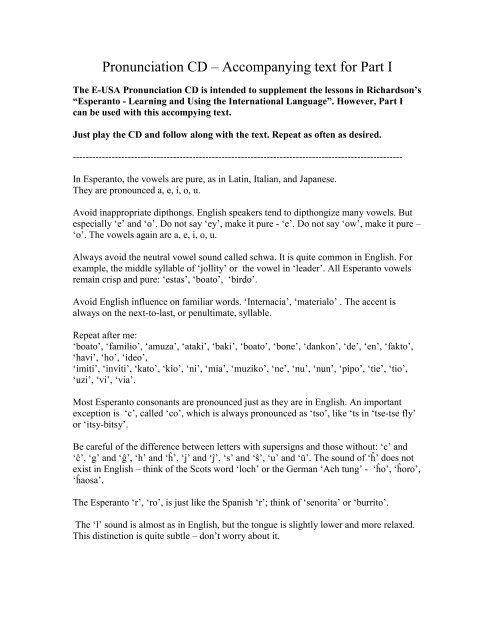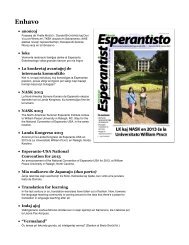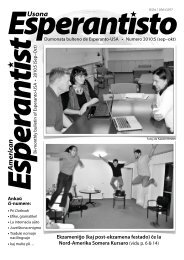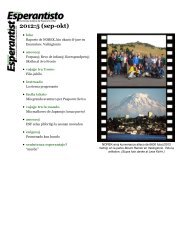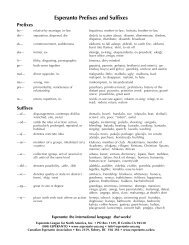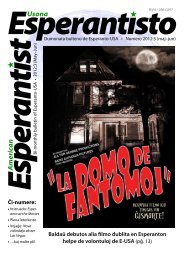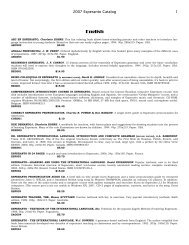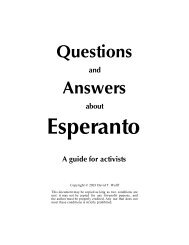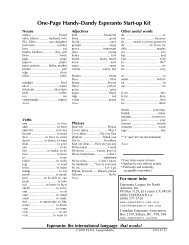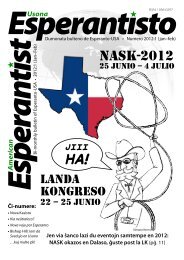Pronunciation CD â Accompanying text for Part I - Esperanto-USA
Pronunciation CD â Accompanying text for Part I - Esperanto-USA
Pronunciation CD â Accompanying text for Part I - Esperanto-USA
You also want an ePaper? Increase the reach of your titles
YUMPU automatically turns print PDFs into web optimized ePapers that Google loves.
<strong>Pronunciation</strong> <strong>CD</strong> – <strong>Accompanying</strong> <strong>text</strong> <strong>for</strong> <strong>Part</strong> I<br />
The E-<strong>USA</strong> <strong>Pronunciation</strong> <strong>CD</strong> is intended to supplement the lessons in Richardson’s<br />
“<strong>Esperanto</strong> - Learning and Using the International Language”. However, <strong>Part</strong> I<br />
can be used with this accompying <strong>text</strong>.<br />
Just play the <strong>CD</strong> and follow along with the <strong>text</strong>. Repeat as often as desired.<br />
------------------------------------------------------------------------------------------------------<br />
In <strong>Esperanto</strong>, the vowels are pure, as in Latin, Italian, and Japanese.<br />
They are pronounced a, e, i, o, u.<br />
Avoid inappropriate dipthongs. English speakers tend to dipthongize many vowels. But<br />
especially ‘e’ and ‘o’. Do not say ‘ey’, make it pure - ‘e’. Do not say ‘ow’, make it pure –<br />
‘o’. The vowels again are a, e, i, o, u.<br />
Always avoid the neutral vowel sound called schwa. It is quite common in English. For<br />
example, the middle syllable of ‘jollity’ or the vowel in ‘leader’. All <strong>Esperanto</strong> vowels<br />
remain crisp and pure: ‘estas’, ‘boato’, ‘birdo’.<br />
Avoid English influence on familiar words. ‘Internacia’, ‘materialo’ . The accent is<br />
always on the next-to-last, or penultimate, syllable.<br />
Repeat after me:<br />
‘boato’, ‘familio’, ‘amuza’, ‘ataki’, ‘baki’, ‘boato’, ‘bone’, ‘dankon’, ‘de’, ‘en’, ‘fakto’,<br />
‘havi’, ‘ho’, ‘ideo’,<br />
‘imiti’, ‘inviti’, ‘kato’, ‘kio’, ‘ni’, ‘mia’, ‘muziko’, ‘ne’, ‘nu’, ‘nun’, ‘pipo’, ‘tie’, ‘tio’,<br />
‘uzi’, ‘vi’, ‘via’.<br />
Most <strong>Esperanto</strong> consonants are pronounced just as they are in English. An important<br />
exception is ‘c’, called ‘co’, which is always pronounced as ‘tso’, like ‘ts in ‘tse-tse fly’<br />
or ‘itsy-bitsy’.<br />
Be careful of the difference between letters with supersigns and those without: ‘c’ and<br />
‘ĉ’, ‘g’ and ‘ĝ’, ‘h’ and ‘ĥ’, ‘j’ and ‘ĵ’, ‘s’ and ‘ŝ’, ‘u’ and ‘ŭ’. The sound of ‘ĥ’ does not<br />
exist in English – think of the Scots word ‘loch’ or the German ‘Ach tung’ - ‘ĥo’, ‘ĥoro’,<br />
‘ĥaosa’.<br />
The <strong>Esperanto</strong> ‘r’, ‘ro’, is just like the Spanish ‘r’; think of ‘senorita’ or ‘burrito’.<br />
The ‘l’ sound is almost as in English, but the tongue is slightly lower and more relaxed.<br />
This distinction is quite subtle – don’t worry about it.
Repeat after me:<br />
‘birdo’, ‘blua’, ‘familio’, ‘honoro’, ‘Karlo’, ‘klubo’, ‘la’, ‘laboro’, ‘lerni’, ‘letero’, ‘li’,<br />
‘lia’, ‘loka’, ‘longa’, ‘Mario’, ‘multa’, ‘Parizo’, ‘patro’, ‘patrino’, ‘por’, ‘prezidanto’,<br />
‘rapidi’, ‘tablo’, ‘tre’.<br />
There are several combinations of vowel plus semi-vowel which behave rather like<br />
dipthongs. The plural ending <strong>for</strong> nouns is ‘oj’, ‘oj’ , ‘lingvo’, ‘lingvoj’. The plural<br />
adjective ending is ‘aj’, ‘aj’, ‘granda’, ‘grandaj’.<br />
‘J’ also combines with ‘u’ to make ‘uj’ as in the adverb ‘tuj’ or the correlatives ‘tiuj’,<br />
‘kiuj’, and so <strong>for</strong>th.<br />
U breve, properly called ‘ŭ’, also combines with vowels <strong>for</strong>ming sounds which behave<br />
rather like dipthongs – ‘eŭ’, ‘aŭ’, ‘Eŭropo’, ‘hodiaŭ’.<br />
Repeat after me:<br />
‘advokato’, ‘amas’, ‘ankaŭ’, ‘certe’, ‘ĉe’ , ‘ĉu ne’, ‘ĉu vere’, ‘decidas’, ‘decidis’,<br />
‘dentisto’, ‘devas’, ‘esperantisto’, ‘estas’, Eŭropo’, ‘granda’, ‘ĝi’, ‘ĝis revido’, ‘ĝis la’,<br />
‘ĝuste’, ‘hejme’, ‘hodiaŭ’, ‘ĥoro’, ‘instruisto’, ‘internacia’, ‘jes’, ‘ĵurnalo’, ‘kaj’, ‘kiel vi<br />
fartas’, ‘konferenco’, ‘kuracas’, ‘lingvoj’, ‘memoras’, ‘poŝto’, ‘saluton’, ‘sed’,<br />
‘universitato’, ‘venis’, ‘vidis’.<br />
Consonant clusters present no problems in <strong>Esperanto</strong> – just pronounce each letter. Some<br />
combinations will need some work: <strong>for</strong> example, ‘kv’ as in ‘kvin’ and ‘kvanto’, ‘kn’ as<br />
in ‘knabo’, ‘gv’ as in ‘gvidi’, ‘sc’ as in ‘scias’.<br />
Repeat after me:<br />
‘kvin’, ‘kvanto’, ‘knabo’, ‘gvidi’, ‘scias’,<br />
Because of its word-combining tendencies, <strong>Esperanto</strong> words will sometimes have<br />
doubled consonants. It is crucial to pronounce each one: ‘malluma’, ‘ekkrias’. Also,<br />
vowels can be doubled, and each needs to be pronounced clearly: ‘taksiisto’, ‘heroo’.<br />
(printed in the Central Office` by Bill Harris – 2008)


